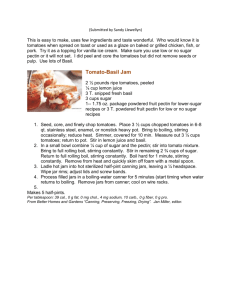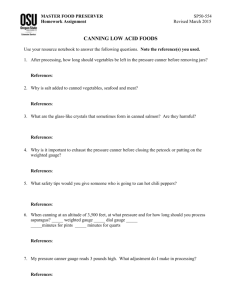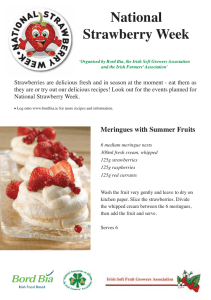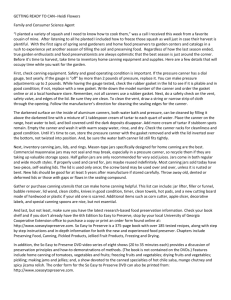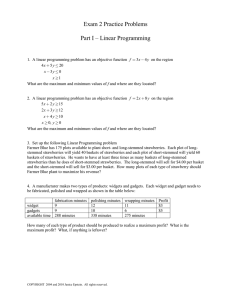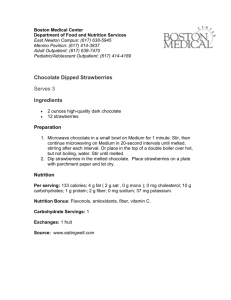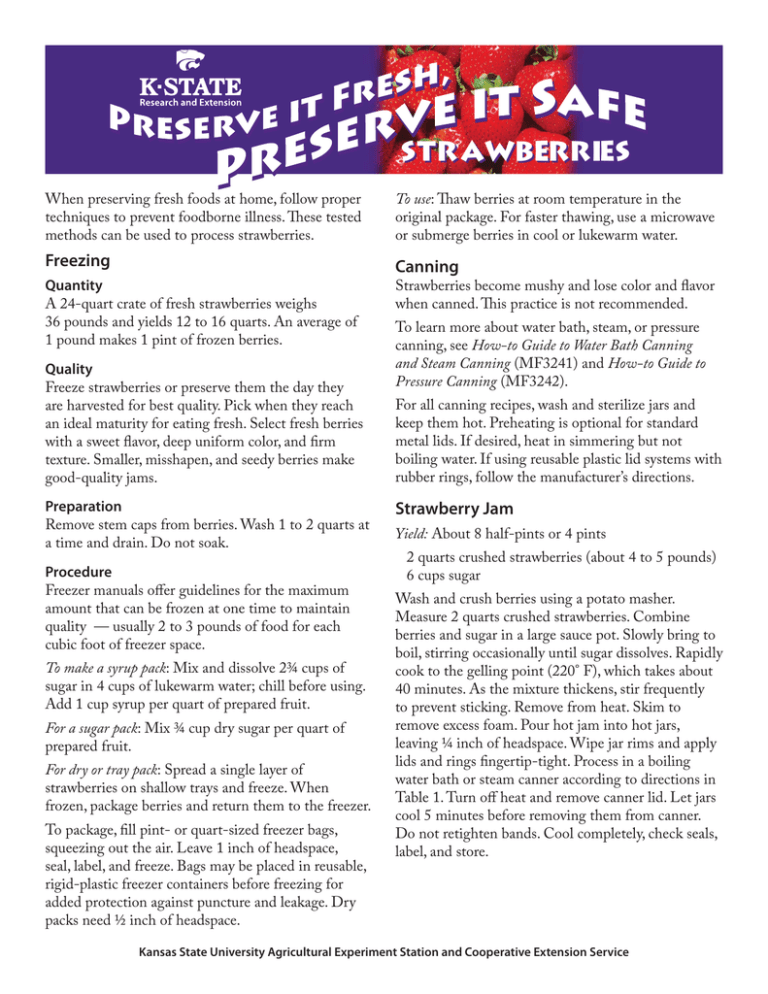
STRAWBERRIES
When preserving fresh foods at home, follow proper
techniques to prevent foodborne illness. These tested
methods can be used to process strawberries.
Freezing
Quantity
A 24-quart crate of fresh strawberries weighs
36 pounds and yields 12 to 16 quarts. An average of
1 pound makes 1 pint of frozen berries.
Quality
Freeze strawberries or preserve them the day they
are harvested for best quality. Pick when they reach
an ideal maturity for eating fresh. Select fresh berries
with a sweet flavor, deep uniform color, and firm
texture. Smaller, misshapen, and seedy berries make
good-quality jams.
Preparation
Remove stem caps from berries. Wash 1 to 2 quarts at
a time and drain. Do not soak.
Procedure
Freezer manuals offer guidelines for the maximum
amount that can be frozen at one time to maintain
quality — usually 2 to 3 pounds of food for each
cubic foot of freezer space.
To make a syrup pack: Mix and dissolve 2¾ cups of
sugar in 4 cups of lukewarm water; chill before using.
Add 1 cup syrup per quart of prepared fruit.
For a sugar pack: Mix ¾ cup dry sugar per quart of
prepared fruit.
For dry or tray pack: Spread a single layer of
strawberries on shallow trays and freeze. When
frozen, package berries and return them to the freezer.
To package, fill pint- or quart-sized freezer bags,
squeezing out the air. Leave 1 inch of headspace,
seal, label, and freeze. Bags may be placed in reusable,
rigid-plastic freezer containers before freezing for
added protection against puncture and leakage. Dry
packs need ½ inch of headspace.
To use: Thaw berries at room temperature in the
original package. For faster thawing, use a microwave
or submerge berries in cool or lukewarm water.
Canning
Strawberries become mushy and lose color and flavor
when canned. This practice is not recommended.
To learn more about water bath, steam, or pressure
canning, see How-to Guide to Water Bath Canning
and Steam Canning (MF3241) and How-to Guide to
Pressure Canning (MF3242).
For all canning recipes, wash and sterilize jars and
keep them hot. Preheating is optional for standard
metal lids. If desired, heat in simmering but not
boiling water. If using reusable plastic lid systems with
rubber rings, follow the manufacturer’s directions.
Strawberry Jam
Yield: About 8 half-pints or 4 pints
2 quarts crushed strawberries (about 4 to 5 pounds)
6 cups sugar
Wash and crush berries using a potato masher.
Measure 2 quarts crushed strawberries. Combine
berries and sugar in a large sauce pot. Slowly bring to
boil, stirring occasionally until sugar dissolves. Rapidly
cook to the gelling point (220° F), which takes about
40 minutes. As the mixture thickens, stir frequently
to prevent sticking. Remove from heat. Skim to
remove excess foam. Pour hot jam into hot jars,
leaving ¼ inch of headspace. Wipe jar rims and apply
lids and rings fingertip-tight. Process in a boiling
water bath or steam canner according to directions in
Table 1. Turn off heat and remove canner lid. Let jars
cool 5 minutes before removing them from canner.
Do not retighten bands. Cool completely, check seals,
label, and store.
Kansas State University Agricultural Experiment Station and Cooperative Extension Service
Strawberry-Rhubarb Jelly
Strawberry-Kiwi Jam
Yield: 7 half-pints
Yield: 6 half-pints
11/2 pounds red stalks of rhubarb (6 cups)
11/2 quarts ripe strawberries (fresh or previously
frozen, unsweetened)
6 cups sugar
2 3-oz. pouches liquid pectin
To prepare juice: Wash and cut rhubarb into 1-inch
pieces. Wash, stem, and crush strawberries. Puree
fruits in a blender or food processor. Pour puree into
a jelly bag or four layers of cheesecloth and gently
squeeze out juice.
To make jelly: Measure 3½ cups of juice into a large
saucepan. Add sugar and mix well. Bring to a boil
over high heat, stirring constantly. Immediately stir
in the pectin. Bring to a full rolling boil and boil hard
for 1 minute, stirring constantly. Remove from heat;
quickly skim off foam. Immediately pour the jelly into
hot canning jars, leaving ¼ inch of headspace. Wipe
jar rims, apply lids and rings fingertip-tight. Process
jars for 5 minutes in a water bath or steam canner
according to directions in Table 1. Turn off heat and
remove canner lid. Let jars cool 5 minutes. Remove
jars from canner, but do not retighten bands. Cool
completely, check seals, label, and store.
Strawberry Jam – No Sugar Needed
Yield: 6 half-pints
2 quarts strawberries
1 cup water
1 package no sugar needed powdered pectin
Wash strawberries; drain. Stem and crush
strawberries. Measure 5 cups. Combine strawberries
and remaining ingredients in a large saucepot,
stirring to dissolve pectin. Bring to a boil, stirring
constantly. Add sweetener according to pectin
package guidelines, if desired. Boil 1 minute, stirring
constantly. If gel starts to form before 1 minute boil is
complete, remove from heat. Ladle hot jam into hot
jars, leaving 1/4 inch of headspace. Remove air bubbles.
Clean jar rim with a damp towel. Apply lids and
rings fingertip-tight. Process in a water bath or steam
canner according to directions in Table 1. Turn off
heat and remove canner lid. Let jars cool 5 minutes.
Remove jars from canner; do not retighten bands.
Cool completely, check seals, label, and store.
3 cups crushed strawberries (about 2 pounds)
3 kiwifruit, peeled and diced
1 tablespoon minced crystallized ginger
6 tablespoons Ball Classic Pectin
1 tablespoon lemon juice
5 cups sugar
Wash strawberries; drain. Remove stems and caps.
Crush strawberries using a potato masher. Measure
3 cups crushed strawberries. Peel kiwifruit and dice.
Combine strawberries, kiwi, ginger, pectin and lemon
juice in a large saucepan. Bring mixture to a boil over
medium-high heat, stirring to blend in pectin. Add
sugar, stirring until sugar dissolves. Bring mixture to a
rolling boil that cannot be stirred down. Boil hard for
1 minute, stirring constantly. Remove from heat.
Skim off foam if necessary. Pour into hot jars, leaving
¼ inch of headspace. Remove air bubbles. Wipe jar
rims, apply lids and rings fingertip-tight. Process in
a water bath or steam canner according to directions
in Table 1. Turn off heat and remove canner lid. Let
jars cool 5 minutes. Remove jars from canner; do not
retighten bands. Cool completely, check seals, label,
and store.
Storing Jams and Jellies
Remove screw bands and check lid seals. If the center
of the lid is indented, wash, dry, label, and store jar
in a clean, cool, dark place. If the lid is unsealed,
examine and replace the jar if defective, use new lids
and reprocess as before. Wash screw bands and store
separately. Jams and jellies are best consumed within
one year.
Table 1. Recommended processing times in a water bath canner or steam canner.
Minutes of processing at different altitudes (in feet)
Product
Style of Pack
Jar Size
0-1,000
1,001-3,000
3,001-6,000
Strawberry Jam
Strawberry-Rhubarb Jelly
Strawberry Jam – No Sugar Needed
Strawberry-Kiwi Jam
Hot
Hot
Hot
Hot
Nutrition per 1 tablespoon jam or jelly
Calories
Half-pints or pints
Half-pints
Half-pints
Half-pints
15
5
10
10
20
10
15
15
25
10
20
20
Carbohydrate (g)
Fat (g)
Vitamin C (mg)
Dietary fiber (g)
Strawberry Jam
39.0
10.1
0.0
5.8
0.3
Strawberry-Rhubarb Jelly
47.0
12.0
0.0
5.5
0.8
Strawberry Jam - No Sugar Needed
4.47
1.1
0.0
8.22
0.3
Strawberry-Kiwi Jam
30.0
8.0
0.0
5.0
0.2
Carbohydrate (g)
Fat (g)
Vitamin C (mg)
Dietary fiber (g)
Nutrition per 1/2 cup frozen strawberries
Calories
Syrup pack
73.0
18.0
0.3
47.0
2.0
Sugar pack
97.0
24.5
0.3
47.0
2.0
Dry pack
25.0
5.8
0.3
47.0
2.0
Problems and Solutions
3. Is paraffin wax safe to use on top of jams and
jellies?
Because of possible mold contamination, paraffin
or wax seals are no longer recommended for any
sweet spread, including jams and jellies. Always
process sweet spreads in a water bath canner or
steam canner to prevent mold and preserve flavor
and color.
1. Why do strawberry pieces float to the top of
jam?
The fruit was either not ripe enough, not crushed
into small pieces, not cooked long enough, or not
packed properly into the jars.
2. How can I reduce the amount of foaming?
Add 1/2 teaspoon butter or margarine to the fruit
mixture before boiling.
3
Revised by Karen Blakeslee, M.S., Extension Associate, Food Science
Adapted from original by Karen P. Penner, Ph.D., and Jeanne Dray, April 1995
Complete Guide to Home Canning, USDA AIB No. 539, 2009, and So Easy to Preserve, 6th ed., The University of Georgia Cooperative Extension Service.
Strawberry Jam Recipe provided by Jarden Home Brands, makers of Ball Brand Fresh Preserving Products. ©2014 Hearthmark, LLC dba Jarden Home Brands.
All Rights Reserved. Distributed by Hearthmark, LLC dba Jarden Home Brands, Daleville, IN 47334. Hearthmark, LLC is a subsidiary of Jarden Corporation (NYSE: JAH).
Brand names appearing in this publication are for product identification purposes only. No endorsement is intended, nor is criticism implied of similar products not mentioned.
Publications from Kansas State University are available at www.ksre.ksu.edu
Publications are reviewed or revised annually by appropriate faculty to reflect current research and practice. Date shown is that of publication or last revision. Contents of this publication may be freely
reproduced for educational purposes. All other rights reserved. In each case, credit Karen Blakeslee et al., Preserve it Fresh, Preserve it Safe Strawberries, Kansas State University, December 2015.
Kansas State University Agricultural Experiment Station and Cooperative Extension Service
MF1178 — December 2015
K-State Research and Extension is an equal opportunity provider and employer. Issued in furtherance of Cooperative Extension Work, Acts of May 8 and June 30, 1914,
as amended. Kansas State University, County Extension Councils, Extension Districts, and United States Department of Agriculture Cooperating, John. D. Floros, Director.

